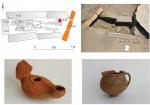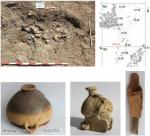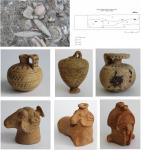Summary (English)
ST. CYRICUS ISLAND (Krastina Panaiotova – kpanayotova@abv.bg, Margarit Damyanov, Teodora Bogdanova) A pit and three graves were explored in Late Antique cemetery. The graves were constructed of roughly-cut stones, ashlars and bricks, including a marble ashlar from an Archaic Greek altar reused in Grave No. 80, which contained a terracotta lamp, a jug, a bronze ring and beads of the end of the 4th century AD. Part of a wall was discovered, built of dry roughly-cut stones, 1.10 m wide and preserved up to 80 cm in height, contemporary to the basilica and the cemetery of the 5th – 7th centuries AD, or later. A stone structure was documented, 4.10 m by 2.70 m in size, probably the foundation of an altar of the Archaic period. Ritual Pit No. 23 was thoroughly explored. The finds included terracotta lamps, a mortarium, dishes, cups and kylikes of the first half of the 6th century BC, including an anthropomorphic aryballos in the shape of the head of a warrior with Corinthian helmet produced in Miletos or Rhodes and dated to the end of the 7th – beginning of the 6th century BC, terracotta figurines, including a figurine of Aphrodite, a stone lamp, an iron xiphos, animal bones and horns. One cup had a graffito of 600 – 575 BC that reads: “… devoted to Apollo the Healer, the Cnidian” in Doric dialect. The man who made the dedication was from Knidos. This find and c. 50 other sherds with graffiti discovered so far indicated the presence of a sanctuary of Apollo that existed before the temple was built at the end of the 6th – beginning of the 5th century BC. Ritual Pit No. 24 was explored, containing dishes, three black-gloss alabastra, an amphoriskos, Corinthian aryballoi of 575 – 550 BC, a terracotta figurine probably of a goddess, two zoomorphic vessels in the shape of a ram probably produced in Corinth, two anthropomorphic vessels, one of them in the shape of the head of a warrior. The earliest pottery from the ritual pits dated to the end of the 7th – first quarter of the 6th centuries BC.
- Krastina Panaiotova - Archaeological Institute with Museum
- Margarit Damyanov - Archaeological Institute with Museum
- Teodora Bogdanova - Archaeological Museum in Sozopol
Director
Team
Research Body
- Archaeological Institute with Museum
- Archaeological Museum in Sozopol






![Download [PDF]](/excavation/skins/fasti/images/results/download_sml.png)

